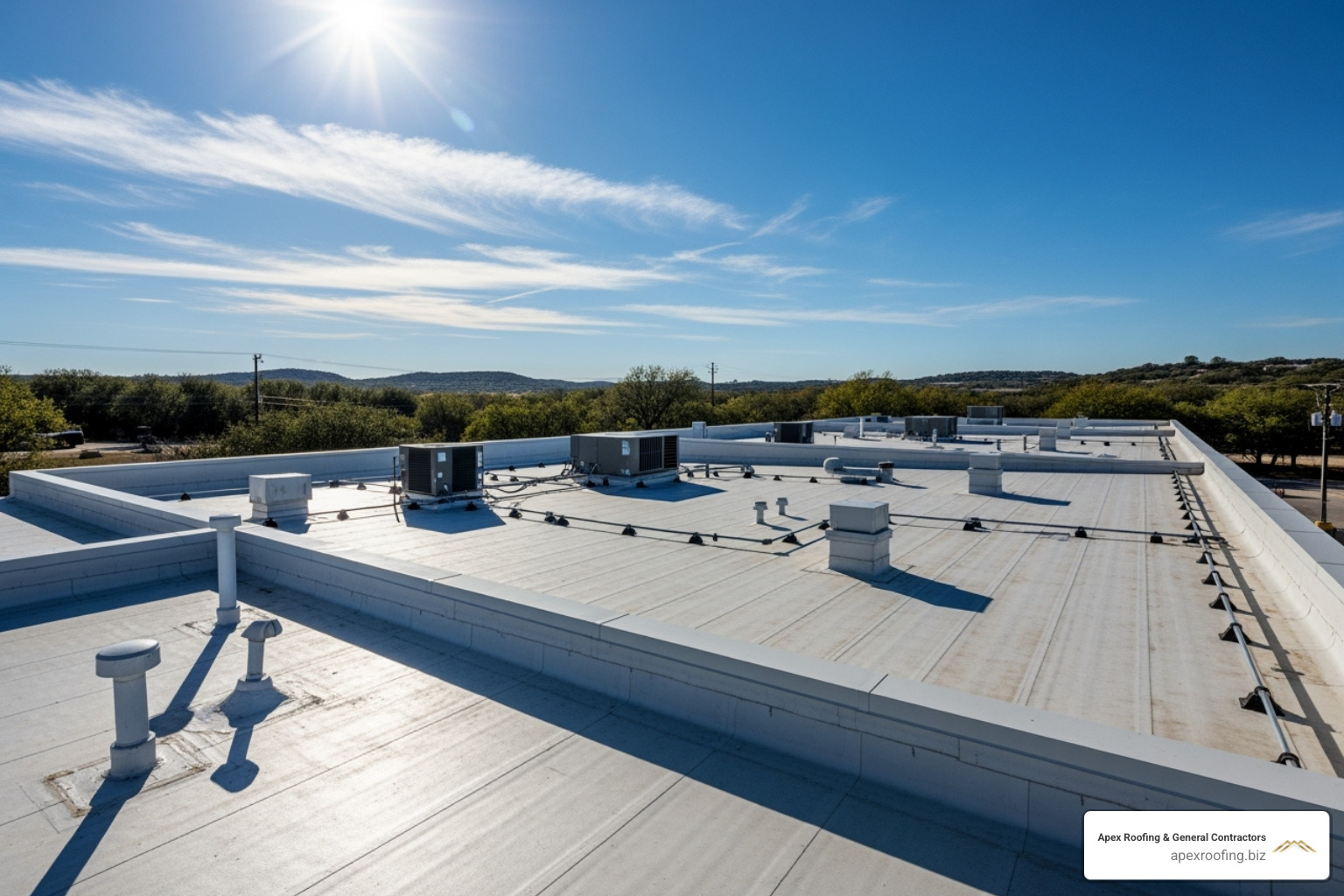Why Handyman Roofing Repair Matters for San Antonio Homeowners
When a few shingles blow off during a South-Texas gust, the quick response is often to call a neighborhood jack-of-all-trades. Yet before you do, take a minute to learn how your roof really works and when you should lean on the certified roofing experts in San Antonio at Apex Roofing & General Contractors. Knowing the difference between a generalist and a licensed specialist is the first step toward safeguarding the biggest investment most of us ever make.
Handyman roofing repair can make sense in very specific situations, but it is not a cure-all. Here’s a fast breakdown:
When Handyman Roofing Repair Works:
- Minor shingle replacement (3–5 shingles)
- Gutter cleaning and minor repairs
- Small fascia or soffit fixes
- Basic weatherproofing tasks
When You Need a Professional:
- Leak detection and repair
- Structural damage assessment
- Insurance claim work
- Warranty-covered repairs
The reality is stark: 86 % of roof failures result from improper installation methods, and professional roofers experience a 42 % lower accident rate than non-specialists. While handymen can save you 20–40 % on truly minor jobs, they often lack the specialized training, insurance coverage, and diagnostic skills required for most roofing issues.
For San Antonio homeowners seeking dependable advice, one neighbor paid a handyman $200 to fix a “small leak” – only to face thousands in water damage when the real problem went undiagnosed. I’m Carlos Yzaguirre, President of Apex Roofing & General Contractors, and after two decades in the local market, I’ve seen how improper handyman roofing repair can turn little issues into major headaches.
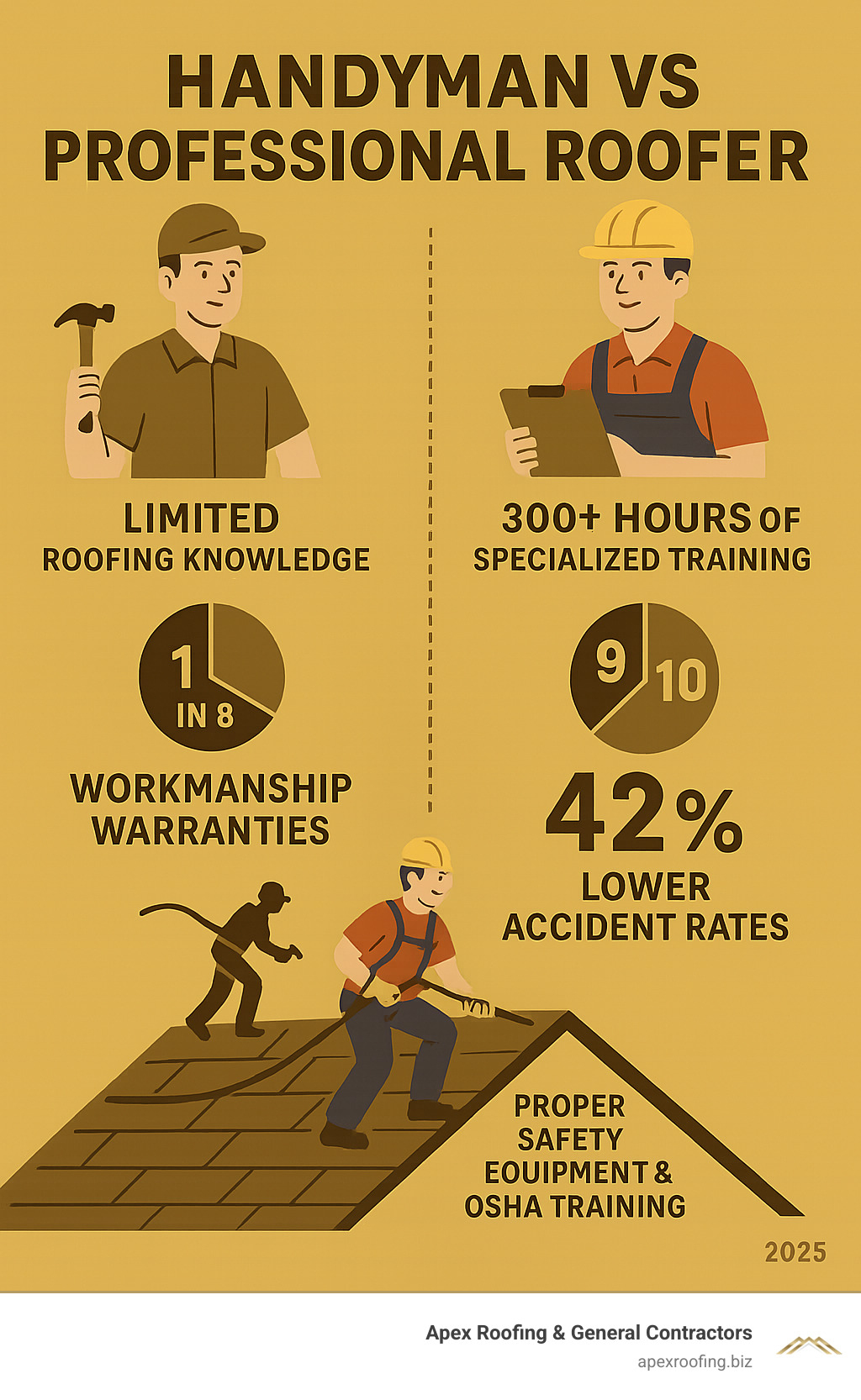
Explore more about handyman roofing repair:
The “Good”: When Can a Handyman Handle Roof Repairs?
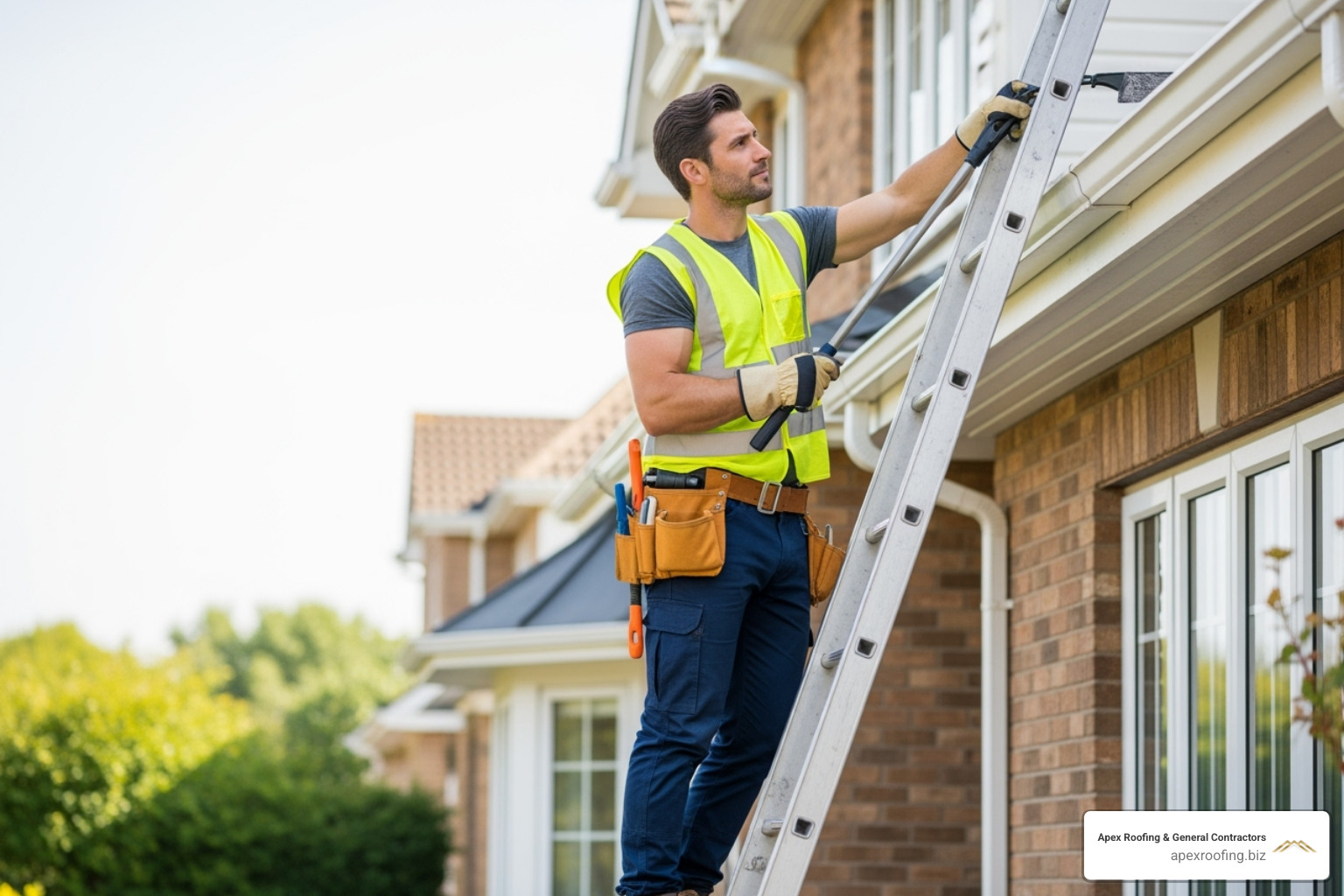
Here’s the truth – not every roof problem needs a full roofing crew. Sometimes, a skilled handyman can handle the simple stuff and save you some serious cash. I’ve seen plenty of competent handymen tackle basic roof-related tasks without breaking a sweat (or your bank account).
The magic word here is “minor.” We’re talking about straightforward jobs that don’t require detective work or specialized roofing knowledge. A good handyman can cut your costs by 20% to 40% on these simple tasks, especially when you’re dealing with routine maintenance rather than actual repairs to your roofing system.
Think of it this way: if the job involves basic maintenance or obvious fixes that don’t require tearing into your roof structure, a handyman might be your guy. But the moment you need diagnosis, structural work, or anything that could affect your home’s weather protection, it’s time to call in the pros.
What Minor Jobs are Suited for a Handyman?
Replacing a few missing shingles tops the list of handyman-friendly tasks. We’re talking about 3-5 shingles that blew off in a storm – the kind where you can see exactly what’s missing and there’s no guesswork involved. The key is that these should be in easy-to-reach spots with no underlying damage to worry about.
Gutter cleaning and downspout repair is another sweet spot for handymen. Clearing out leaves, adjusting downspouts, and fixing minor gutter damage doesn’t require roofing expertise. It’s dirty work that most homeowners would rather avoid, and a handyman can knock it out efficiently.
Minor fascia and soffit repairs work well too, especially when you’re dealing with small sections of damaged boards or basic trim work around roof edges. This is more about carpentry skills than roofing knowledge, which plays to most handymen’s strengths.
Simple weatherproofing tasks like applying caulk to small gaps or making minor flashing adjustments (not replacements) can also be handyman territory. The emphasis here is on “simple” – we’re not talking about complex sealing work that requires understanding water flow patterns.
The bottom line? These tasks should be obvious, low-risk, and not require any detective work to figure out what’s really going on. Some minor roof-related tasks can be suitable for a skilled handyman, particularly when they involve maintenance rather than actual handyman roofing repair of your roofing system.
But here’s the catch – even with these “simple” jobs, your handyman needs proper insurance, safety equipment, and the wisdom to know when they’re in over their head. I’ve seen too many $200 “quick fixes” turn into $5,000 problems when underlying issues went unnoticed.
The “Bad”: Critical Risks of Handyman Roofing Repair
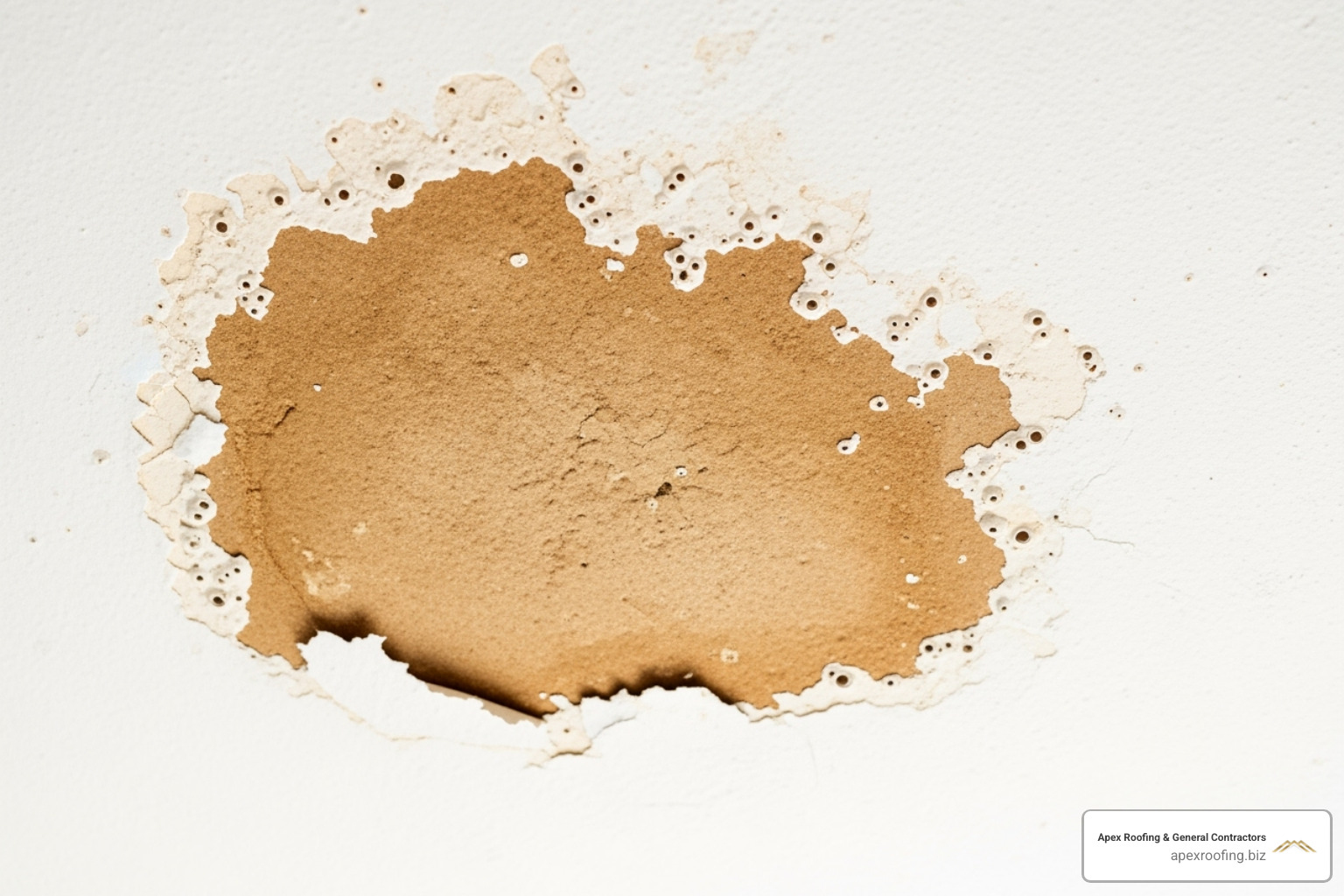
Here’s where things get uncomfortable. While that handyman roofing repair might seem like a smart way to save money, the reality is often far more expensive than you’d imagine. After two decades in San Antonio’s roofing industry, I’ve seen too many homeowners learn this lesson the hard way.
The problem isn’t that handymen are bad people – many are skilled and well-intentioned. The issue is that roofing is a complex system where everything works together. When someone without specialized training attempts repairs, they might fix what they can see while missing the real problem lurking underneath.
Think of it like this: if your car’s engine light comes on, you wouldn’t ask your neighbor to pop the hood and guess what’s wrong. Yet that’s essentially what happens when untrained workers tackle roofing issues.
The Hidden Costs of a “Cheaper” Fix
The statistics tell a sobering story: 86 % of roof failures result from improper installation methods. When you consider that certified roofing contractors receive over 300 hours of specialized training, this number starts to make sense.
Here’s what we’ve witnessed when homeowners choose the “budget” option:
Water damage escalation is the most common nightmare. A simple mistake during repair can create new entry points for water, leading to damaged insulation and drywall, mold growth requiring professional remediation, structural decay in wooden components, and ruined personal belongings. One client came to us after a handyman “fixed” a small leak – by the time we assessed the damage, water had spread throughout the attic and into three bedrooms.
Energy efficiency loss is another hidden cost. Improper repairs often compromise your home’s thermal envelope, resulting in higher heating and cooling bills, inconsistent indoor temperatures, and increased wear on your HVAC system. We’ve seen San Antonio homeowners face $200+ monthly increases in energy costs due to botched repairs.
Repeat repair cycles become inevitable without proper diagnosis. The underlying problem persists, leading to multiple repair attempts, escalating damage over time, and eventually requiring complete replacement. Total costs often exceed what professional repair would have cost initially.
For homeowners wondering why is my roof leaking?, the answer frequently lies in previous improper repairs that addressed symptoms rather than root causes.
How a Handyman Roofing Repair Impacts Your Insurance and Warranty
This is where the real financial pain begins. Most homeowners don’t realize that choosing unlicensed labor for roofing work can void both manufacturer warranties and insurance coverage.
Manufacturer warranty voidance happens more often than you’d think. Most roofing material manufacturers require proof that qualified professionals installed their products. When a handyman performs repairs, material warranties become void, future claims are denied, and homeowners bear the full cost of defective materials. Your home’s resale value may also be impacted.
Insurance policy complications are equally serious. Insurance companies increasingly scrutinize roofing work, and unlicensed repairs can result in denied claims for water damage, policy cancellation for non-compliance, personal liability for worker injuries, and fines for violating contractor licensing laws.
The numbers are stark: nine out of ten established roofing companies provide workmanship warranties, while only one in eight handymen offer comparable warranty protection. You’re essentially gambling with your home’s protection.
We’ve seen insurance companies refuse $15,000 claims for water damage because unlicensed labor was used for repairs. The homeowner not only lost their insurance coverage but also faced personal liability when the handyman was injured on the job.
Safety, Liability, and Lack of Expertise
The safety statistics should make every homeowner pause. Professional roofers experience a 42 % lower accident rate than non-specialists, and there’s a good reason why.
Your liability exposure becomes significant when you hire an uninsured handyman. You’re responsible for medical bills if they’re injured, costs can reach $50,000 or more for serious injuries, your homeowner’s insurance may not cover these claims, and legal complications can arise from worker injuries.
Diagnostic limitations are perhaps the most frustrating aspect. Handymen typically lack the specialized knowledge to identify underlying structural issues, understand water flow patterns, recognize signs of manufacturing defects, or assess the impact of repairs on the entire roofing system.
Equipment and material deficiencies create additional problems. Professional roofers have access to specialized safety equipment, high-quality materials through supplier relationships, proper tools for precise installation, and weather-appropriate timing for repairs.
The result speaks for itself: roof work completed by trained professionals leads to a 35 % decrease in callback rates for the same issue. When you need reliable help, the expertise gap between handymen and certified roofers becomes crystal clear.
The “Leaky” to the “Legendary”: Why a Professional Roofer is the Gold Standard
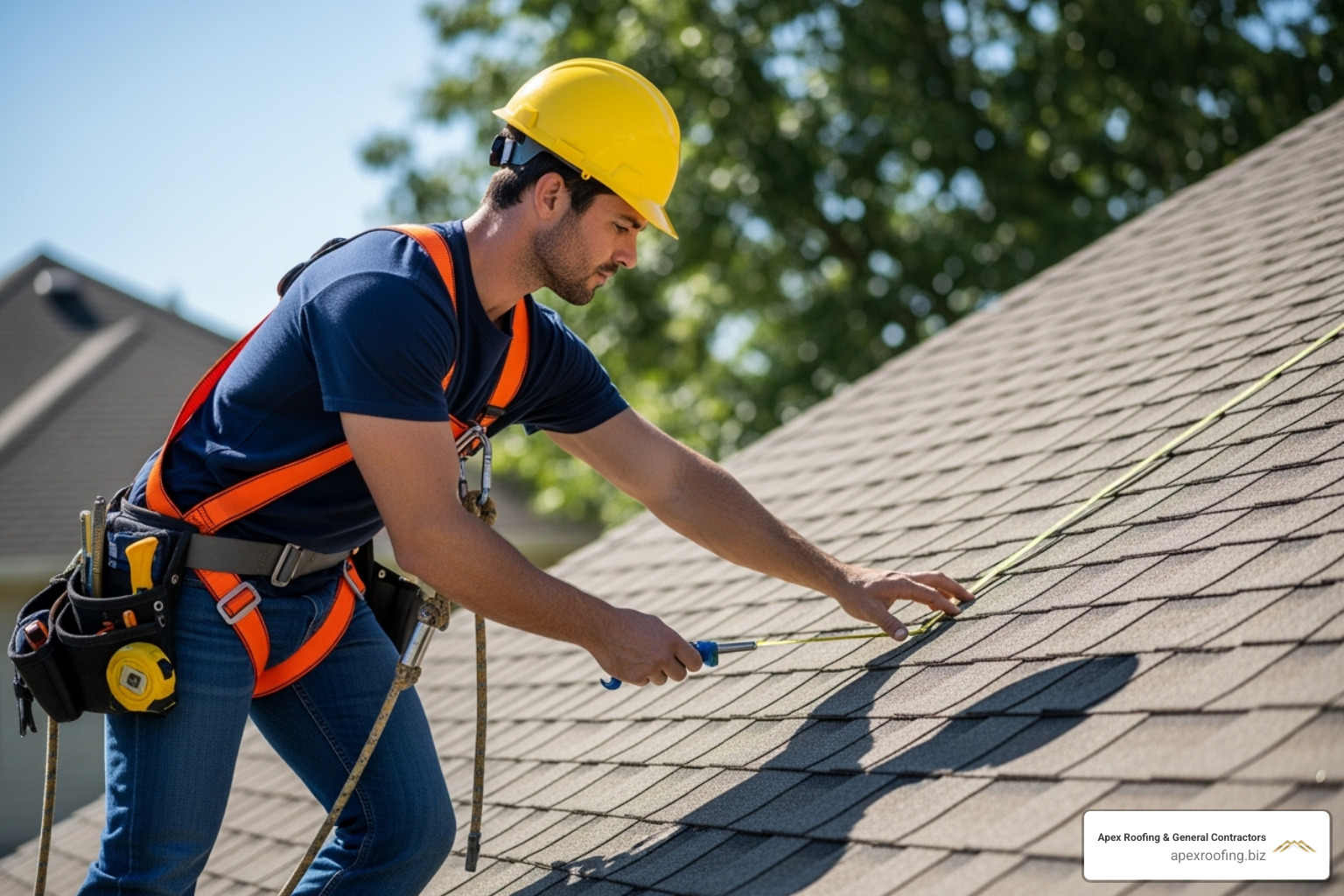
Here’s where the story takes a turn for the better. After witnessing countless handyman roofing repair disasters, working with a professional roofer feels like switching from a flip phone to a smartphone – you suddenly realize what you’ve been missing.
Professional roofers don’t just fix problems; they solve them permanently. When you hire a certified contractor, you’re not just paying for labor – you’re investing in expertise, accountability, and peace of mind that comes from knowing the job is done right the first time.
For homeowners who want to dive deeper into roof care, our roofing blog offers practical tips, case studies, and maintenance checklists that expand on the points below.
Expertise and Proper Diagnosis
Think of the difference between a family doctor and a brain surgeon. Both are medical professionals, but when you need specialized care, you want the specialist. The same principle applies to roofing.
Professional roofers approach every job like detectives. They don’t just look at where water is dripping in your living room – they trace it back to its source, which might be twenty feet away from where you see the problem. This systematic approach comes from over 300 hours of specialized training that covers everything from water flow patterns to material compatibility.
We recently had a client who’d hired three different handymen to fix a “simple leak” above their kitchen. Each time, the leak returned within months. When we investigated, we found the real problem was a poorly installed flashing around a skylight installed years earlier. The handymen had been patching symptoms while the root cause continued wreaking havoc.
The diagnostic skills make all the difference. Professional roofers understand how different roofing materials interact, how weather affects various components, and how to spot potential problems before they become expensive disasters. This expertise explains why roof work completed by trained professionals leads to a 35 % decrease in callback rates – they fix it right the first time.
During our comprehensive assessments, we often find issues that homeowners had no idea existed: hidden structural damage, compromised ventilation systems, or manufacturer defects that could lead to complete system failure. A handyman might replace visible damaged shingles and call it good, while a professional ensures the entire system functions properly.
Guaranteed Work and Code Compliance
Here’s where professional roofers really shine – they stand behind their work with more than just a handshake and a promise. Nine out of ten established roofing companies provide workmanship warranties, compared to only one in eight handymen. That’s not just a statistic – it’s your financial protection.
Licensed contractors operate within a framework of accountability that protects you in multiple ways. They carry workers’ compensation insurance, general liability coverage often exceeding $500,000, and professional liability insurance. When someone gets hurt on your property, you’re protected. When something goes wrong with the work, you have recourse.
Building code compliance isn’t optional – it’s the law. In San Antonio and throughout Bexar County, roofing work must meet specific standards. Professional roofers understand current code requirements, obtain necessary permits, and schedule required inspections. This isn’t just bureaucratic paperwork – it’s what keeps your family safe and your insurance valid.
The licensing requirements exist for good reason. They ensure minimum competency standards, require ongoing education, and provide consumer protection mechanisms. When you hire a licensed contractor, you’re working with someone who’s proven their knowledge and maintains it through continuing education.
We’ve seen homeowners face thousands in fines and forced repairs when unlicensed work failed inspection. One client had to completely redo their roof because a handyman’s work didn’t meet code requirements, and the city red-tagged their home during a routine inspection.
Access to Superior Materials and Tools
Professional roofers have access to resources that handymen simply can’t match, and these advantages translate directly into better outcomes for your home. Our relationships with material manufacturers and wholesale distributors mean we can access higher-quality materials at better prices, plus we get technical support when complex situations arise.
The equipment difference is night and day. Professional roofers use commercial-grade safety equipment, specialized installation tools, and diagnostic instruments that cost more than most handymen’s entire tool collections. This isn’t about showing off – it’s about precision, safety, and getting results that last.
Material quality matters more than most homeowners realize. Professional contractors can access manufacturer-certified materials with extended warranty options, weather-appropriate products designed for Texas conditions, and specialized components for complex installations. The difference between contractor-grade and retail materials often means the difference between a repair that lasts decades versus one that fails within months.
When storm damage strikes, professional roofers know how to properly assess damage, work with insurance adjusters, and ensure repairs meet all requirements for claim approval. We understand the documentation insurance companies require and can provide the detailed reports that get claims approved quickly.
For homeowners wanting lasting solutions, professional contractors offer the complete package – from accurate diagnosis through quality repairs to ongoing warranty support. It’s the difference between crossing your fingers and sleeping soundly knowing your home is properly protected.
Making the Right Call: A Homeowner’s Checklist

Making the right decision about handyman roofing repair versus professional contractor services doesn’t have to be complicated. After decades of helping San Antonio homeowners protect their investments, I’ve developed a straightforward approach that takes the guesswork out of this important choice.
The key is understanding what you’re looking at and knowing the right questions to ask. Most homeowners can spot obvious problems, but the subtle signs often tell the bigger story about your roof’s condition.
Signs Your Roof Needs Attention
Your roof constantly communicates its condition – you just need to know what to look for. I always tell homeowners to think like a detective when inspecting their roof, looking for clues both inside and outside their home.
Start with the obvious exterior signs. Missing, cracked, or curling shingles are your roof’s way of waving a red flag. When you see granules accumulating in gutters or scattered across your driveway, that’s your shingles literally shedding their protective coating. Don’t ignore damaged or missing flashing around chimneys, vents, or skylights – these areas are where most leaks begin.
More concerning signs include a sagging roof deck or any visible structural deformation. If you notice moss, algae, or excessive debris accumulation, your roof isn’t draining properly, which can lead to bigger problems.
Interior warning signs often appear before exterior damage becomes obvious. Water stains on ceilings or walls are clear indicators of water intrusion, even if you haven’t seen an active leak. Blistering or peeling exterior paint around the roofline suggests moisture problems.
Check your attic regularly for obvious leaks or water intrusion, and trust your nose – musty odors often signal mold growth from hidden moisture. If your energy bills have increased unexpectedly, your roof’s insulation might be compromised by water damage.
After any storm event, conduct a careful inspection. Look for missing or damaged shingles, dented materials, damaged gutters, or debris impact damage. Texas weather can be brutal, and storm damage often creates entry points for future problems.
The golden rule? Act promptly when you notice these signs. I’ve seen too many cases where homeowners delayed repairs, turning a $300 fix into a $3,000 disaster.
Vetting Your Pro: Handyman vs. Contractor
Once you’ve identified a problem, the decision process becomes clearer when you know what questions to ask and what red flags to watch for.
For truly minor issues, a qualified handyman might be appropriate, but you still need to do your homework. Ask potential handymen: “Can you provide references for similar roofing work?” A legitimate handyman should have examples of successful small roofing projects. “Do you carry liability insurance and workers’ compensation?” Never hire anyone who can’t provide proof of insurance – you’ll be liable for any accidents.
Other critical questions include: “Are you familiar with local building codes?” and “What warranty do you offer on your work?” Even for minor repairs, you deserve some guarantee on the work performed.
Red flags with handymen include no insurance or bonding, unwillingness to provide references, pressure for immediate payment, lack of written estimates, or no understanding of permit requirements. If they can’t answer basic questions about your roofing material, keep looking.
For major issues, you need a professional contractor, and the vetting process becomes more rigorous. Start with: “Can I see your license and insurance certificates?” Any legitimate contractor will readily provide these documents. Ask about manufacturer certifications – certified contractors have access to better materials and warranties.
“How long have you been in business locally?” matters because roofing is relationship-based. You want someone who’ll be around if warranty issues arise. Request local references from recent projects and actually call them. Ask about warranties on materials and workmanship – professional contractors typically offer comprehensive coverage.
Essential questions include: “Will you handle permit applications and inspections?” and “How do you handle insurance claims?” Professional contractors steer these processes routinely.
Essential contractor credentials include a current state contractor’s license, workers’ compensation insurance, general liability insurance (minimum $500,000), local business license, solid Better Business Bureau rating, and relevant manufacturer certifications.
The decision becomes clearer when you apply this simple framework: Choose a handyman when repairs involve fewer than five shingles, no structural damage is visible, work is limited to gutters or fascia, no insurance claim is involved, and the handyman has proper insurance and references.
Choose a professional when any leak is involved, structural damage is suspected, an insurance claim is being filed, work involves flashing or complex areas, warranty coverage is important, or building permits are required.
Getting multiple estimates is always wise, whether you’re considering a handyman or professional contractor. Get at least three written estimates, but compare scope of work, not just price. Verify all contractors are properly licensed and insured, ask about timeline and cleanup procedures, and understand what’s included versus what costs extra.
If you’re online searching for roofers near me in San Antonio, credentials, insurance, and experience should matter more than the lowest bid.
Documentation requirements include written estimates with detailed scope of work, proof of insurance and licensing, material specifications and warranties, timeline for completion, and cleanup and disposal procedures.
The importance of professional roof inspections cannot be overstated. Even if you’re considering a handyman for minor work, a professional assessment can reveal hidden issues that might make professional repair necessary.
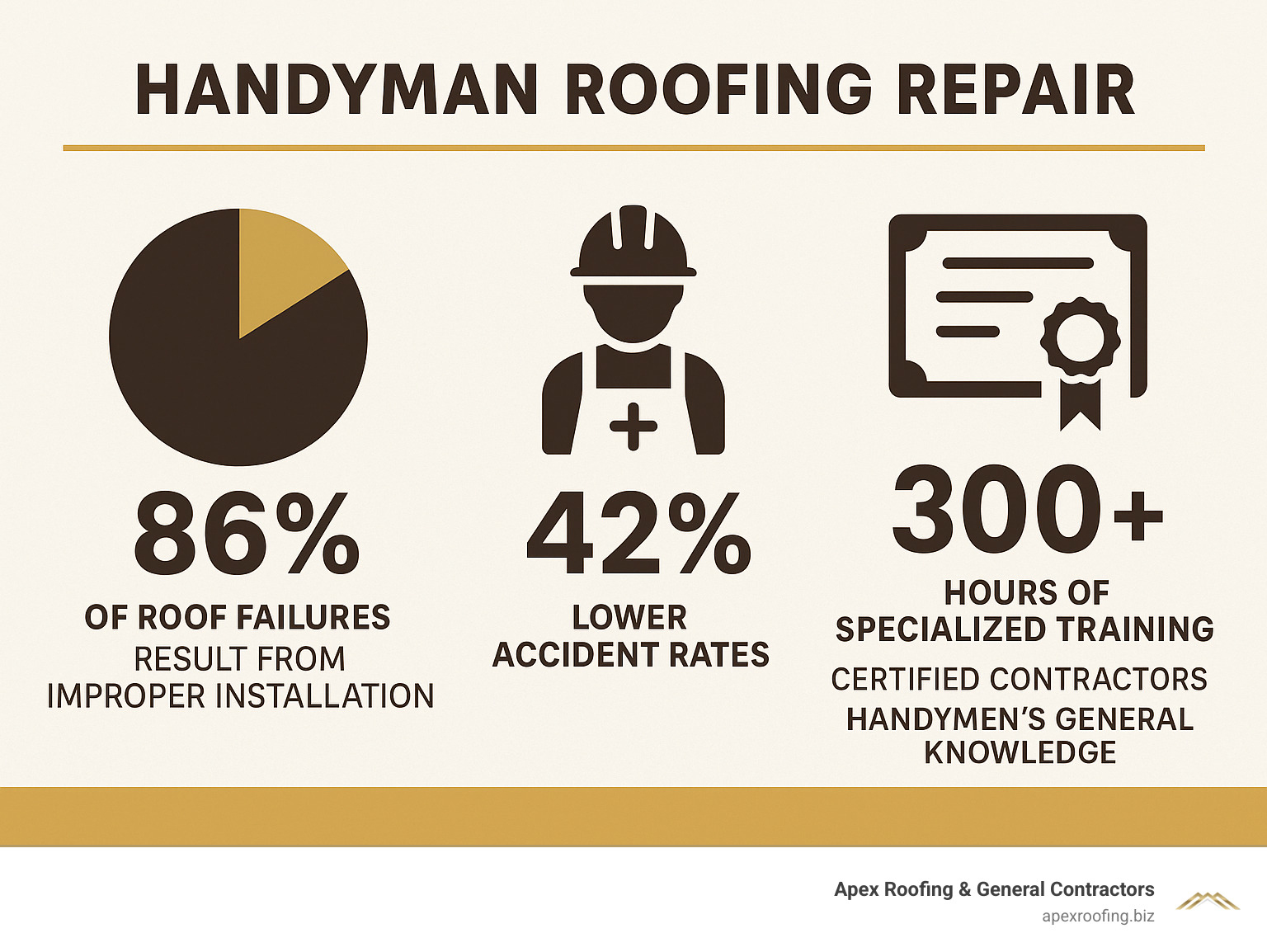
The goal isn’t finding the cheapest option – it’s finding the right solution that protects your home and investment. Sometimes paying more upfront prevents much larger costs later.
Conclusion
The choice between a handyman and a professional roofer comes down to risk versus reward. While a handyman might offer a quick, cheap fix for the simplest of issues, the potential for voided warranties, denied insurance claims, and costly future damage makes a licensed professional the wisest choice for protecting your home.
The Bottom Line on Handyman Roofing Repair:
When handyman roofing repair works, it’s limited to very minor, low-risk tasks like gutter cleaning, replacing a few shingles, or basic maintenance – and only when the handyman has proper insurance and solid references. But when it doesn’t work, the consequences can be devastating.
The statistics tell the story clearly: 86 % of roof failures result from improper installation methods, and the financial risks of voided warranties and denied insurance claims far outweigh any initial savings. We’ve seen too many homeowners learn this lesson the hard way.
The Smart Homeowner’s Approach:
Start by assessing the scope – is this truly a minor, cosmetic issue or could it indicate a larger problem lurking beneath the surface? Then consider the consequences – can you really afford to be wrong about the severity of the issue?
Evaluate long-term costs honestly. Will saving a few hundred dollars now potentially cost you thousands when the quick fix fails? Whether you’re considering a handyman or contractor, always check credentials – verify insurance, licensing, and references without exception.
When in doubt, get a professional assessment. It’s far better to pay for an expert opinion upfront than to find you needed one after the damage is done.
For homeowners throughout San Antonio, Helotes, Leon Valley, Alamo Heights, Fair Oaks Ranch, Shavano Park, Terrell Hills, and Bexar County, we at Apex Roofing & General Contractors understand the importance of getting it right the first time. Our team of licensed professionals brings decades of experience, comprehensive insurance coverage, and a commitment to building code compliance that protects your investment.
We’ve witnessed countless situations where homeowners tried to save money with handyman roofing repair only to face exponentially higher costs when the quick fix failed. Our approach focuses on proper diagnosis, quality materials, and workmanship warranties that give you genuine peace of mind.
Whether you’re dealing with storm damage, aging roofing materials, or mysterious leaks, our certified team provides the expertise your home deserves. We give free estimates and encourage you to call (726) 727-7663 to schedule your free inspection or learn more about our handyman roofing repair services.
When it comes to your roof, the real question isn’t whether you can afford professional service – it’s whether you can afford not to have it done right the first time. Your family’s safety and your home’s value depend on making the right choice.


